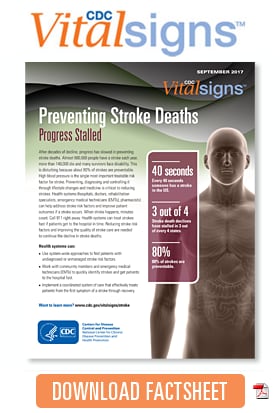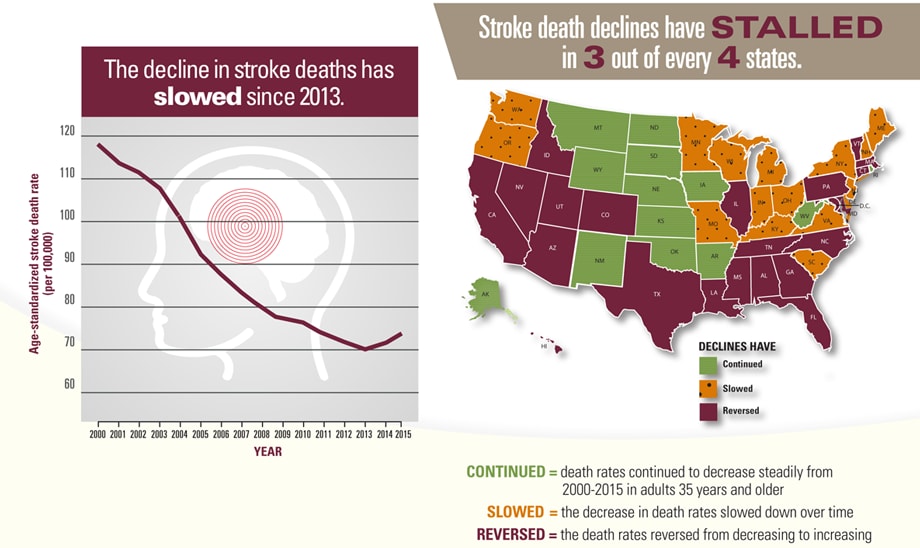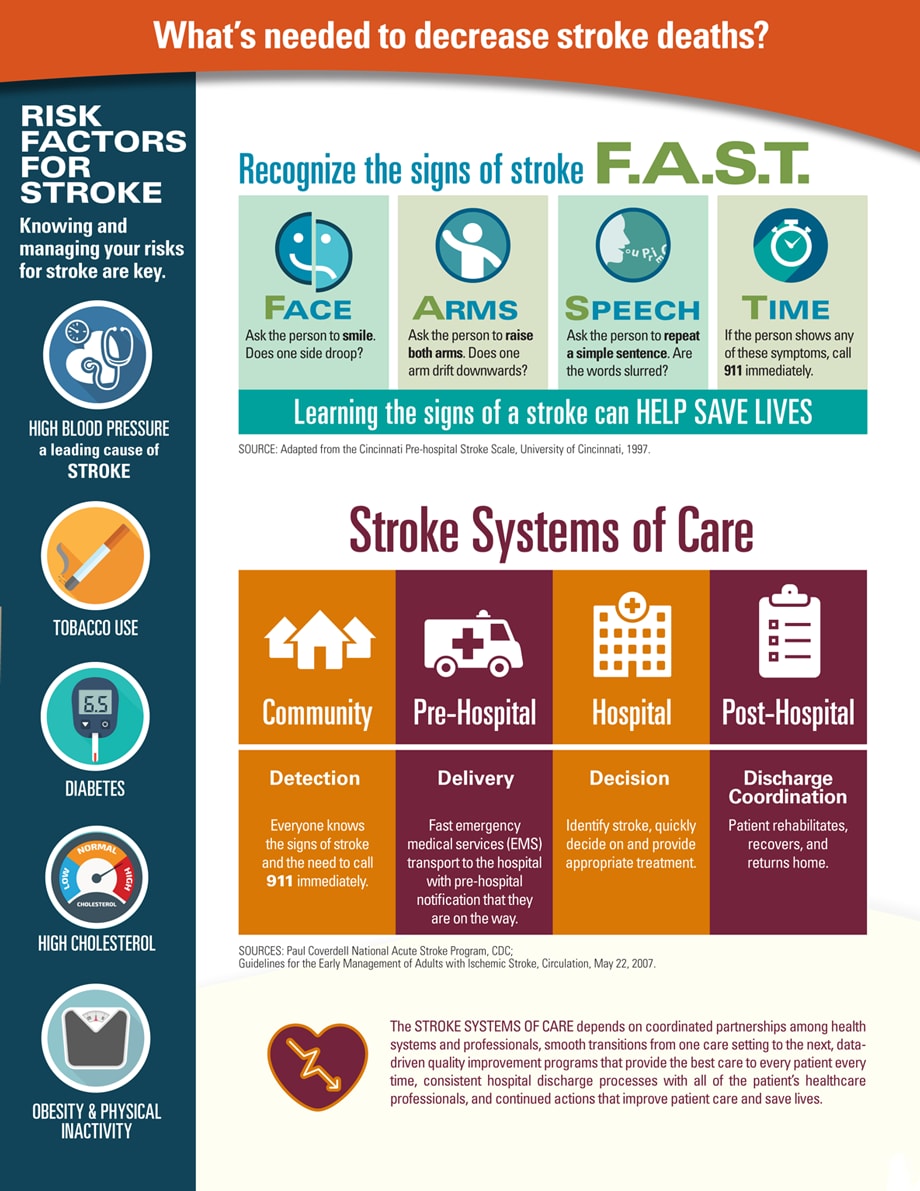
Preventing Stroke Deaths
Progress Stalled
Overview
After decades of decline, progress has slowed in preventing stroke deaths. Almost 800,000 people have a stroke each year, more than 140,000 die and many survivors face disability. This is disturbing because about 80% of strokes are preventable. High blood pressure is the single most important treatable risk factor for stroke. Preventing, diagnosing and controlling it through lifestyle changes and medicine is critical to reducing strokes. Health systems (hospitals, doctors, rehabilitation specialists, emergency medical technicians [EMTs], pharmacists) can help address stroke risk factors and improve patient outcomes if a stroke occurs. When stroke happens, minutes count. Call 911 right away. Health systems can treat strokes fast if patients get to the hospital in time. Reducing stroke risk factors and improving the quality of stroke care are needed to continue the decline in stroke deaths.
Health systems can:
- Use system-wide approaches to find patients with undiagnosed or unmanaged stroke risk factors.
- Work with community members and emergency medical technicians (EMTs) to quickly identify strokes and get patients to the hospital fast.
- Implement a coordinated system of care that effectively treats patients from the first symptom of a stroke through recovery.


Every 40 seconds someone has a stroke in the US.
Stroke death declines have stalled in 3 out of every 4 states.
80% of strokes are preventable.
Problem
Stroke deaths have stopped declining.
Strokes are common and preventable.
- Stroke is the 5th leading cause of death and a leading cause of serious, long-term disability, with an estimated cost of $34 billion annually.
- 1 in 20 adult deaths are due to stroke. Many of these deaths are preventable.
- When stroke happens, parts of the brain become damaged and can start to die within minutes.
Strokes happen more in some populations and geographic areas.
- Stroke death declines have stalled in 3 out of every 4 states.
- Blacks have the highest stroke death rates among all races/ethnicities.
- Stroke death rates among Hispanics have increased by 6% each year from 2013 to 2015.
- Stroke deaths increased in southern states.
Strokes are happening at younger ages.
- Risk factors like high blood pressure, high cholesterol, obesity, and diabetes are happening at younger ages.
- Risk factors may not be recognized and treated in middle-aged adults (35-64 years old).
- Recent studies also suggest that over the last 15 years younger adults (ages 18-54) have had increases in stroke hospitalizations, along with increases in stroke risk factors among those hospitalized with stroke.

View large image and text description
Infographics

View large image and text description
What Can Be Done
The Federal government is
- Managing the Paul Coverdell National Acute Stroke Program (Coverdell Program) that partners with state health departments, emergency medical services (EMS), and hospitals to implement data driven quality improvement programs for stroke care. https://go.usa.gov/xRNM5
- Leading the Million Hearts® initiative to prevent1 million heart attacks and strokes by 2022. Millionhearts.hhs.gov
- Providing resources to all 50 states to address chronic disease prevention, including heart disease and stroke.
- Funding stroke research in treatment, recovery, and prevention, and supporting the Mind Your Risks public education campaign. Mindyourrisks.nih.gov
Health systems can
- Use system-wide approaches to find patients with undiagnosed or unmanaged stroke risk factors.
- Work with community members and emergency medical technicians (EMTs) to quickly identify strokes and get patients to the hospital fast.
- Implement a coordinated system of care that effectively treats patients from the first symptom of a stroke through recovery.
Doctors, nurses and healthcare professionals can
- Identify and treat high blood pressure, obesity, diabetes, high cholesterol, smoking, and other risk factors for stroke.
- Help patients control their blood pressure, cholesterol, and diabetes by taking medicines as directed and making lifestyle changes that can help prevent stroke.
- Refer patients to community resources such as smoking quit lines and obesity and diabetes prevention programs that will support their lifestyle behavior changes.
- Educate patients on the signs and symptoms of stroke and the importance of calling 911 if someone is having a stroke.
State health departments can
- Prioritize coordinated stroke systems of care and adopt successful strategies of the Coverdell Program.
- Use data to identify and improve gaps in stroke care to drive quality improvements.
- Train community members and emergency medical technicians (EMTs) to identify the signs of stroke and understand the importance of getting patients to the hospital quickly.
- Increase awareness of risk factors for stroke and lifestyle changes needed among high-risk populations.
- Conduct public education campaigns on the importance of calling 911.
Everyone can
- Recognize the signs and symptoms of stroke and call 911 if someone is having a stroke.
- Control blood pressure and cholesterol by taking medicines as prescribed.
- Manage other medical conditions, such as obesity and diabetes.
- Avoid smoking and secondhand smoke, which increase your risk for stroke.
- Eat a healthy diet low in salt and sugar with lots of fresh fruits and vegetables, increase physical activity, and maintain a healthy weight.






















.png)









No hay comentarios:
Publicar un comentario